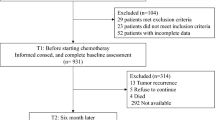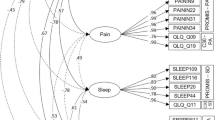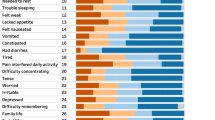Abstract
Objective
This study aimed to evaluate the conceptual structure of the European Organization for Research and Treatment of Cancer Quality of Life Core Questionnaire 30 (EORTC QLQ-C30) by analyzing data collected from patients with major cancers in Taiwan. The conceptual structure underlying QLQ-C30, including higher-order factors, was explored by structural equation modeling (SEM).
Methods
The Taiwan Chinese version of the EORTC QLQ-C30 was used as the measuring instrument. Higher-order models, including mental health/physical health, mental function/physical burden, symptom burden/function, single latent health-related quality of life, formative symptom burden/function, and formative health-related quality of life, were tested.
Results
Study subjects included 283 patients with breast, lung, and nasopharyngeal cancers. The original QLQ-C30 multi-factorial structure demonstrated poor composite reliability of the cognitive function subscale. The formative symptom/burden model was favored by model fit indices, further supporting causal–indicator duality, but was compromised by unexpected associations between symptomatic subscales and latent factors. The formative health-related quality of life was proposed with a single second-order latent factor where symptomatic subscales remained formative. Two additional symptom measures from the formal cognitive function subscale with the formative health-related quality-of-life model were proposed as the alterative conceptual structure for the Taiwan Chinese QLQ-C30.
Conclusions
Results of the current study represent the complete SEM approach for the EORTC QLQ-C30. The formative health-related quality-of-life model with elimination of cognitive function enhances the conceptual structure of the Taiwan Chinese version with parsimonious fit and interpretability.








Similar content being viewed by others
References
Lipscomb, J., Snyder, C. F., & Gotay, C. C. (2007). Cancer outcomes measurement: Through the lens of the medical outcomes trust framework. Quality of Life Research, 16, 143–164.
Robling, M., Matthews, S. J., Hood, K., Russell, I. T., Holloway, R., Wilkinson, C., et al. (2002). The development of a new site-specific measure of quality of life for breast problems: The Cardiff breast scales. Quality of Life Research, 11, 339–348.
Kaptein, A. A., Morita, S., & Sakamoto, J. (2005). Quality of life in gastric cancer. World Journal of Gastroenterology, 11, 3189–3196.
Aaronson, N. K., Ahmedzai, S., Bergman, B., Bullinger, M., Cull, A., Duez, N. J., et al. (1993). The European Organization for Research and Treatment of Cancer QLQ-C30: A quality-of-life instrument for use in international clinical trials in oncology. Journal of the National Cancer Institute, 85, 365–376.
Bergman, B., Aaronson, N. K., Ahmedzai, S., Kaasa, S., & Sullivan, M. (1994). The EORTC QLQ-LC13: A modular supplement to the EORTC core Quality of Life Questionnaire (QLQ-C30) for use in lung cancer clinical trials. European Journal of Cancer, 30A, 635–642.
Sprangers, M. A., Groenvold, M., Arraras, J. I., Franklin, J., te Velde, A., Muller, M., et al. (1996). The European Organization for Research and Treatment of Cancer-Specific Quality-of-Life Questionnaire Module first results from a three-country field study. Journal of Clinical Oncology, 14, 2756–2768.
Bjordal, K., Hammerlid, E., Ahlner-Elmqvist, M., de Graeff, A., Boysen, M., Evensen, J. F., et al. (1999). Quality of life in head and neck cancer patients: Validation of the European Organization for Research and Treatment of Cancer Quality of Life Questionnaire-H&N35. Journal of Clinical Oncology, 17, 1008–1019.
Chie, W. C., Chang, K. J., Huang, C. S., & Kuo, W. H. (2003). Quality of life of breast cancer patients in Taiwan: Validation of the Taiwan Chinese version of the EORTC QLQ-C30 and EORTC BR-23. Psychooncology, 12, 729–735.
Chie, W. C., Hong, R. L., Lai, C. C., Ting, L. L., & Hsu, M. M. (2003). Quality of life in patients of nasopharyngeal carcinoma: Validation of the Taiwan Chinese version of the EORTC QLQ-C30 and the EORTC QLQ-H&N35. Quality of Life Research, 12, 93–98.
Chie, W. C., Yang, C. H., Hsu, C., & Yang, P. C. (2004). Quality of life of lung cancer patients: Validation of Taiwan Chinese version of the EORTC QLQ-C30 and QLQ-LC13. Quality of Life Research, 13, 257–262.
Huang, C. C., Lien, H. H., Sung, Y. C., Liu, H. T., & Chie, W. C. (2007). Quality of life of patients with gastric cancer in Taiwan: Validation and clinical application of the Taiwan Chinese version of the EORTC QLQ-C30 and EORTC QLQ-STO22. Psychooncology, 16, 945–949.
Campbell, D. T., & Fiske, D. W. (1959). Convergent and discriminant validation by the multitrait–multimethod matrix. Psychological Bulletin, 56, 81–105.
Fayers, P. M., Hand, D. J., Bjordal, K., & Groenvold, M. (1997). Causal indicators in quality of life research. Quality of Life Research, 6, 393–406.
Boehmer, S., & Luszczynska, A. (2006). Two kinds of items in quality of life instruments: ‘Indicator and causal variables’ in the EORTC QLQ-C30. Quality of Life Research, 15, 131–141.
McDonald, R. (1999). Test theory: A unified treatment. London: Lawrence Erlbaum.
Fayer, P., & Machin, D. (2007). Quality of Life: The assessment, analysis and interpretation of patient-reported outcomes (2nd ed.). New York: Wiley.
Fayers, P. M., & Hand, D. J. (1997). Factor analysis, causal indicators and quality of life. Quality of Life Research, 6, 139–150.
Gundy, C. M., Fayers, P. M., Groenvold, M., Petersen, M. A., Scott, N. W., Sprangers, M. A., et al. (2012). Comparing higher order models for the EORTC QLQ-C30. Quality of Life Research, 21, 1607–1617.
Huang, C. C., Lien, H. H., Tu, S. H., Huang, C. S., Jeng, J. Y., Chao, H. L., et al. (2010). Quality of life in Taiwanese breast cancer survivors with breast-conserving therapy. Journal of the Formosan Medical Association, 109, 493–502.
Cronbach, L. J. (1951). Coefficient alpha and the internal consistency of tests. Psychometrika, 16, 297.
Hays, R. D., & Hayasi, T. (1990). Beyond internal consistency reliability: Rationale and user’s guide for multitrait analysis program on the microcomputer. Behavior Research Methods, Instruments, & Computers, 22, 167–175.
Howard, K. I., & Forehand, G. G. (1962). A method for correcting item total correlations for the effect of relevant item inclusion. Educational and Psychological Measurement, 22, 731–735.
Hayduk, L. A. (1987). Structural equation modeling with LISREL: Essentials and Advances. Baltimore: Johns Hopkins University Press.
Hu, L. T., & Bentler, P. M. (1999). Cutoff criteria for fit indexes in covariance structure analysis: Conventional criteria versus new alternatives. Structural Equation Modeling, 6, 1–55.
Bagozzi, R. P., & Yi, Y. (1989). The degree of intention formation as a moderator of the attitude-behavior relationship. Social Psychology Quarterly, 52, 266–279.
Bentler, P. M., & Bonett, D. G. (1980). Significance tests and goodness of fit in the analysis of covariance structures. Psychological Bulletin, 88, 588–606.
Jarvenpaa, S. L., Tractinsky, N., & Vitale, M. (2000). Consumer trust in an internet store. Information Technology and Management, 1, 45–71.
McDonald, R. P., & Ho, M. R. (2002). Principles and practice in reporting structural equation analyses. Psychological Methods, 7, 64–82.
Hair, J. F., Anderson, R. E., Tatham, R. L., & Black, W. C. (1998). Multivariate data analysis (5th ed.). Englewood Cliffs: Prentice Hall.
Fornell, C., & Larcker, D. F. (1981). Evaluating structural equation models with unobservable variables and measurement error. Journal of Marketing Research, 18, 39–50.
Hatcher, L. (1994). A step-by-step approach to using the SAS system for factor analysis and structural equation modeling. Cary: SAS Institute.
Netemeyer, R. G., Johnston, M. W., & Burton, S. (1990). Analysis of role conflict and role ambiguity in a structural equation framework. Journal of Applied Psychology, 75, 148–157.
Hair, J. F., William, C. B., Barry, J. B., & Rolph, E. A. (2009). Multivariate data analysis (7th ed.). Englewood Cliffs: Prentice Hall.
MacCallum, R., Browne, M., & Sugawara, H. M. (1996). Power analysis and determination of sample size for covariance structure modeling. Psychological Methods, 2, 130–149.
Ware, J. E., & Sherbourne, C. D. (1992). The MOS 36-item short-form health survey (SF-36). I: Conceptual framework and item selection. Medical Care, 30, 473–483.
Yun, Y. H., Park, Y. S., Lee, E. S., Bang, S. M., Heo, D. S., Park, S. Y., et al. (2004). Validation of the Korean version of the EORTC QLQ-C30. Quality of Life Research, 13, 863–868.
Luo, N., Fones, C. S., Lim, S. E., Xie, F., Thumboo, J., & Li, S. C. (2005). The European Organization for Research and Treatment of Cancer Quality of Life Questionnaire (EORTC QLQ-C30): Validation of English version in Singapore. Quality of Life Research, 14, 1181–1186.
Kobayashi, K., Takeda, F., Teramukai, S., Gotoh, I., Sakai, H., Yoneda, S., et al. (1998). A cross-validation of the European Organization for Research and Treatment of Cancer QLQ-C30 (EORTC QLQ-C30) for Japanese with lung cancer. European Journal of Cancer, 34, 810–815.
Hong, Z., & Katsuya, K. (2004). Testing psychometric properties of the standard Chinese version of the European Organization for Research and Treatment of Cancer Quality of Life Core Questionnaire 30 (EORTC QLQ-C30). Journal of Epidemiology, 14, 193–203.
Montazeri, A., Harirchi, I., Vahdani, M., Khaleghi, F., Jarvandi, S., Ebrahimi, M., & Haji-Mahmoodi, M. (1999). The European Organization for Research and Treatment of Cancer Quality of Life Questionnaire (EORTC QLQ-C30): Translation and validation study of the Iranian version. Supportive Care in Cancer, 7, 400–406.
Silpakit, C., Sirilerttrakul, S., Jirajarus, M., Sirisinha, T., Sirachainan, E., & Ratanatharathorn, V. (2006). The European Organization for Research and Treatment of Cancer Quality of Life Questionnaire (EORTC QLQ-C30): Validation study of the Thai version. Quality of Life Research, 15, 167–172.
Chaukar, D. A., Das, A. K., Deshpande, M. S., Pai, P. S., Pathak, K. A., Chaturvedi, P., et al. (2005). Quality of life of head and neck cancer patient: Validation of the European organization for research and treatment of cancer QLQ-C30 and European organization for research and treatment of cancer QLQ-H&N 35 in Indian patients. Indian Journal of Cancer, 42, 178–184.
Keller, S. D., Ware, J. E, Jr, Bentler, P. M., Aaronson, N. K., Alonso, J., Apolone, G., et al. (1998). Use of structural equation modeling to test the construct validity of the SF-36 Health Survey in ten countries: Results from the IQOLA Project. International Quality of Life Assessment. Journal of Clinical Epidemiology, 51, 1179–1188.
Anagnostopoulos, F., Niakas, D., & Pappa, E. (2005). Construct validation of the Greek SF-36 health survey. Quality of Life Research, 14, 1959–1965.
Ringdal, G. I., & Ringdal, K. (1993). Testing the EORTC Quality of Life Questionnaire on cancer patients with heterogeneous diagnoses. Quality of Life Research, 2, 129–140.
Huang, C. C., Lien, H. H., Wang, P. C., Yang, J. C., Cheng, C. Y., & Huang, C. S. (2007). Quality of life in disease-free adenocarcinoma survivors: Impacts of clinical stages and reconstructive surgical procedures. Digestive Surgery, 24, 59–65.
Smith, A. B., Cocks, K., Taylor, M., & Parry, D. (2014). Most domains of the European Organisation for Research and Treatment of Cancer Quality of Life Questionnaire C30 are reliable. Journal of Clinical Epidemiology, 67, 952–957.
Tabachnick, B. G., & Fidell, L. S. (2006). Using multivariate statistics (5th ed.). Needham Heights: Allyn & Bacon.
Bentler, P. M., & Yuan, K. H. (1999). Structural equation modeling with small samples: Test statistics. Multivariate Behavioral Research, 34, 181–197.
Comrey, A. L., & Lee, H. B. (1992). A first course in factor analysis (2nd ed.). Hillsdale: Lawrence Erlbaum Associates.
Chen, F. F., West, S. G., & Sousa, K. H. (2006). A comparison of bifactor and second-order models of quality of life. Multivariate Behavioral Research, 41, 189–225.
Acknowledgments
The work was supported in part by Cathay Medical Research Institute grant MR10208 and National Science Council grant NSC-102-2314-B-281-003-MY3 and MOST-103-2314-B-281-004-MY2.
Conflict of interest
All authors declared no competing interests.
Author information
Authors and Affiliations
Corresponding author
Electronic supplementary material
Below is the link to the electronic supplementary material.
Rights and permissions
About this article
Cite this article
Huang, CC., Tu, SH., Lien, HH. et al. Conceptual structure of the Taiwan Chinese version of the EORTC QLQ-C30. Qual Life Res 24, 1999–2013 (2015). https://doi.org/10.1007/s11136-014-0913-3
Accepted:
Published:
Issue Date:
DOI: https://doi.org/10.1007/s11136-014-0913-3




